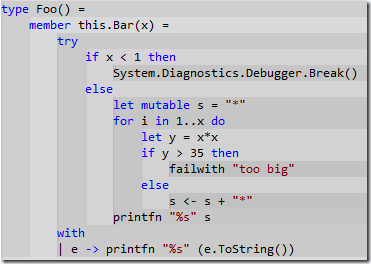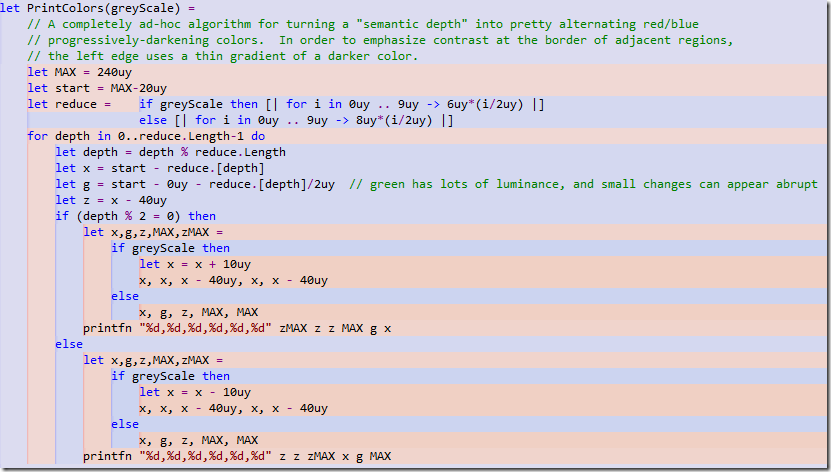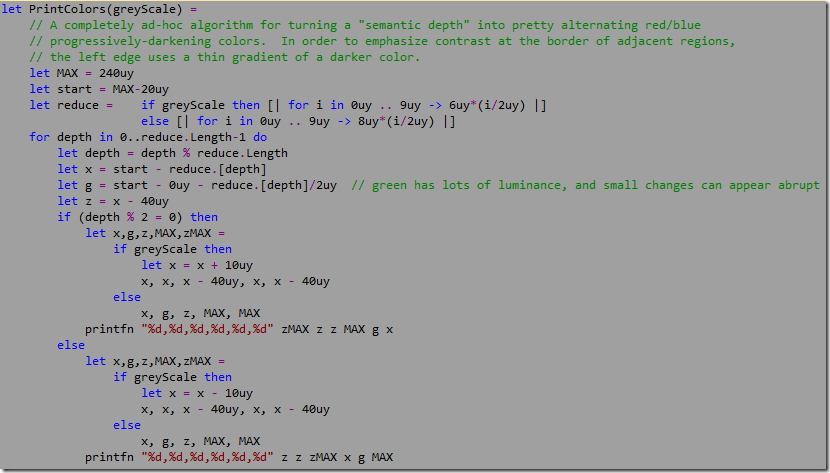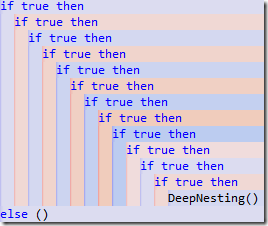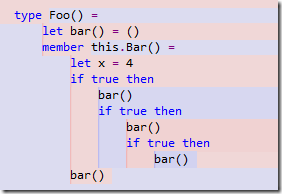What kind of fool posts a cool extension for colorizing F# source code structure, but then only lets you configure the colors by editing the registry (and then having to restart Visual Studio to see if the new colors look ok)?
Oh, that was me. :)
Like I said in the previous blog, I don’t have the skills to design a good GUI to edit the colors or figure out the most discoverable place in VS to edit them. But maybe you do! And so in the spirit of sharing source, here’s a crummy (but working) standalone app for experimenting with the colors. A screenshot is suggestive:

Basically, you can click on one of the rectangles, and then use the buttons to change the R/G/B values of the left-edge color or the main color. And once you have colors you like, you can click a different button which prints out a .reg file you can use to install those colors. (The app only reads the registry, it does not write it, so you have to copy-paste the text from the console window, save it to a .reg file, and run it if you want to install your updated colors.)
Anyway, the code is below. Just throw this in an F# Console Application, add references to the WPF assemblies (PresentationCore, PresentationFramework, System.Xaml, System.Xml, UIAutomationTypes, and WindowsBase), press Ctrl-F5 to build and run and you’re off to the races. Feel free to steal all this code to build your own better app/extension, or just to use to build your own attractive color schemes. The code is just a quick ugly hack, but hopefully you can work with it.
And yes, I’ll be releasing the code for the actual editor colorizer extension soon, I just want to finish tidying it up a little. (Thanks to those who have already left feedback and pointed out minor bugs!)
Quickie code for app to manage editing colors:
open System.Windows
open System.Windows.Controls
open System.Windows.Data
open System.Windows.Media
open System.Windows.Shapes
open Microsoft.Win32
type IIndexable<'a> =
abstract member Item : int -> 'a
let makeBinding(sourceObj:obj, sourcePath:string, converter:'T->'U,
targetObj:DependencyObject, targetDependencyProperty:DependencyProperty) =
let b = new System.Windows.Data.Binding()
b.Source <- sourceObj
b.Path <- new System.Windows.PropertyPath(sourcePath)
b.Converter <-
{ new System.Windows.Data.IValueConverter with
member this.Convert(v, targetType, param, culInfo) =
box(converter (unbox v))
member this.ConvertBack(v, targetType, param, culInfo) =
raise <| new System.NotImplementedException() }
BindingOperations.SetBinding(targetObj, targetDependencyProperty, b) |> ignore
type MyWindow() as this =
inherit Window()
static let selectedRectangleNumber =
DependencyProperty.Register("SelectedRectangleNumber", typeof<int>, typeof<MyWindow>,
new FrameworkPropertyMetadata(0, FrameworkPropertyMetadataOptions.AffectsRender,
new PropertyChangedCallback(fun depObj ea ->
match box depObj, box ea.NewValue with
| (:? MyWindow as w), (:? int as x) -> w.TriggerSelectedRectangleNumberChanged(x)
| _ -> ())))
let selectedChanged = new Event<Handler<int>,int>()
let getNum() = this.GetValue(MyWindow.SelectedRectangleNumber) :?> int
let setNum(n) = this.SetValue(MyWindow.SelectedRectangleNumber, n)
let colors =
try
let key = Registry.CurrentUser.OpenSubKey(
@"Software\Microsoft\VisualStudio\10.0\Text Editor\FSharpDepthColorizer")
Array.init 10 (fun i -> key.GetValue(sprintf "Depth%d" i) :?> string)
|> Array.map (fun s -> let [|r1;g1;b1;r2;g2;b2|] = s.Split[|','|] |> Array.map byte
r1,g1,b1,r2,g2,b2)
with e ->
[| // greyscale colors
190uy,190uy,190uy,230uy,230uy,230uy
170uy,170uy,170uy,210uy,210uy,210uy
184uy,184uy,184uy,224uy,224uy,224uy
164uy,164uy,164uy,204uy,204uy,204uy
178uy,178uy,178uy,218uy,218uy,218uy
158uy,158uy,158uy,198uy,198uy,198uy
172uy,172uy,172uy,212uy,212uy,212uy
152uy,152uy,152uy,192uy,192uy,192uy
166uy,166uy,166uy,206uy,206uy,206uy
146uy,146uy,146uy,186uy,186uy,186uy
|]
// why the SolidColorBrush below?
// to have a DependencyObject to data-bind... there is probably a cleaner way, but oh well
let edgeColors = colors |> Array.map (fun (r,g,b,_,_,_) -> SolidColorBrush(Color.FromRgb(r,g,b)))
let mainColors = colors |> Array.map (fun (_,_,_,r,g,b) -> SolidColorBrush(Color.FromRgb(r,g,b)))
let brushes =
let makeGradientStop(b:SolidColorBrush, pct) =
let gs = new GradientStop(b.Color, pct)
makeBinding(b, "Color", (fun (c:Color) -> c), gs, GradientStop.ColorProperty)
gs
{ new IIndexable<Brush> with
member this.Item depth =
upcast new LinearGradientBrush(
new GradientStopCollection(
[|
makeGradientStop(edgeColors.[depth], 0.0)
makeGradientStop(mainColors.[depth], 0.01)
makeGradientStop(mainColors.[depth], 1.0)
|] ), new Point(0.0, 0.5), new Point(1.0, 0.5)) }
let printCurrentSettings() =
printfn "Windows Registry Editor Version 5.00"
printfn ""
printfn "[HKEY_CURRENT_USER\Software\Microsoft\VisualStudio\10.0\Text Editor\FSharpDepthColorizer]"
for i in 0..9 do
let ec = edgeColors.[i].Color
let mc = mainColors.[i].Color
printfn "\"Depth%d\"=\"%d,%d,%d,%d,%d,%d\"" i ec.R ec.G ec.B mc.R mc.G mc.B
let mkButton(colors:SolidColorBrush[], text, dr, dg, db) =
let b = new Button()
b.Content <- text
b.Click.Add(fun _ -> colors.[getNum()].Color <-
Color.FromRgb(colors.[getNum()].Color.R + byte dr,
colors.[getNum()].Color.G + byte dg,
colors.[getNum()].Color.B + byte db))
b
let mkButtonPanel(colors:SolidColorBrush[],text,dr,dg,db,f) =
let panel = new StackPanel(Orientation = Orientation.Horizontal)
let tb = new TextBlock()
selectedChanged.Publish.Add(fun _ ->
makeBinding(colors.[getNum()], "Color", (fun (c:Color) -> f(c).ToString()),
tb, System.Windows.Controls.TextBlock.TextProperty))
panel.Children.Add(mkButton(colors, text+" down",-dr,-dg,-db)) |> ignore
panel.Children.Add(tb) |> ignore
panel.Children.Add(mkButton(colors, text+" up",dr,dg,db)) |> ignore
panel
do
let leftPanel = new StackPanel(Orientation = Orientation.Vertical)
leftPanel.Children.Add(mkButtonPanel(edgeColors,"edge R",2,0,0,(fun c->c.R))) |> ignore
leftPanel.Children.Add(mkButtonPanel(edgeColors,"edge G",0,2,0,(fun c->c.G))) |> ignore
leftPanel.Children.Add(mkButtonPanel(edgeColors,"edge B",0,0,2,(fun c->c.B))) |> ignore
leftPanel.Children.Add(mkButtonPanel(mainColors,"main R",2,0,0,(fun c->c.R))) |> ignore
leftPanel.Children.Add(mkButtonPanel(mainColors,"main G",0,2,0,(fun c->c.G))) |> ignore
leftPanel.Children.Add(mkButtonPanel(mainColors,"main B",0,0,2,(fun c->c.B))) |> ignore
let printButton = new Button(Content="Print current settings to console")
printButton.Click.Add(fun _ -> printCurrentSettings())
leftPanel.Children.Add(printButton) |> ignore
let mainPanel = new StackPanel(Orientation = Orientation.Horizontal)
mainPanel.Children.Add(leftPanel) |> ignore
let canvas = new Canvas()
for i in 0..mainColors.Length-1 do
let rect = new Rectangle(Width=600., Height=500., Fill = brushes.[i])
rect.MouseDown.Add(fun _ -> setNum(i))
Canvas.SetLeft(rect, (float i)*30.)
Canvas.SetTop(rect, (float i)*30.)
Canvas.SetZIndex(rect, i)
canvas.Children.Add(rect) |> ignore
let rect = new Rectangle(Width=600., Height=40.)
selectedChanged.Publish.Add(fun _ -> rect.Fill <- brushes.[getNum()])
Canvas.SetLeft(rect, 0.)
Canvas.SetTop(rect, (float mainColors.Length)*30. + 20.)
Canvas.SetZIndex(rect, mainColors.Length)
canvas.Children.Add(rect) |> ignore
mainPanel.Children.Add(canvas) |> ignore
this.Content <- mainPanel
member private this.TriggerSelectedRectangleNumberChanged(x:int) = selectedChanged.Trigger(this, x)
static member SelectedRectangleNumber = selectedRectangleNumber
[<System.STAThread>]
do
(new Application()).Run(MyWindow()) |> ignore

